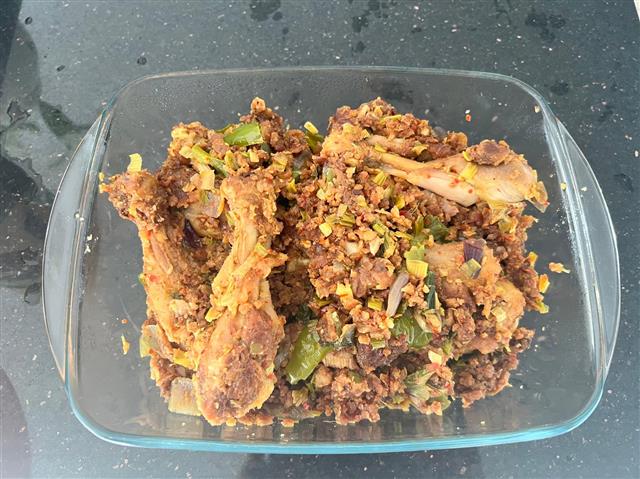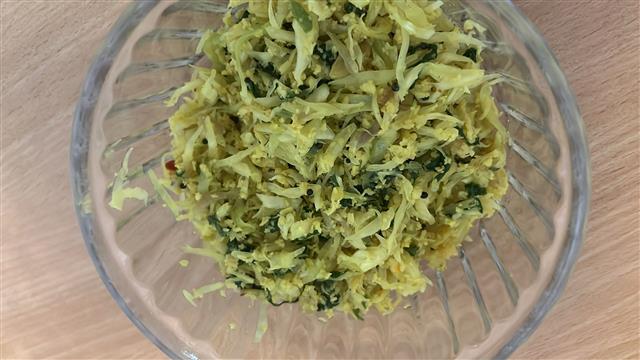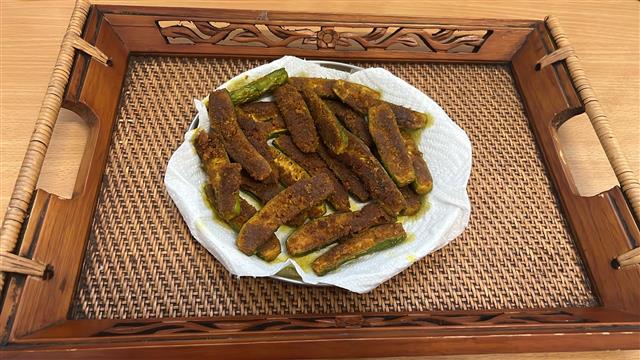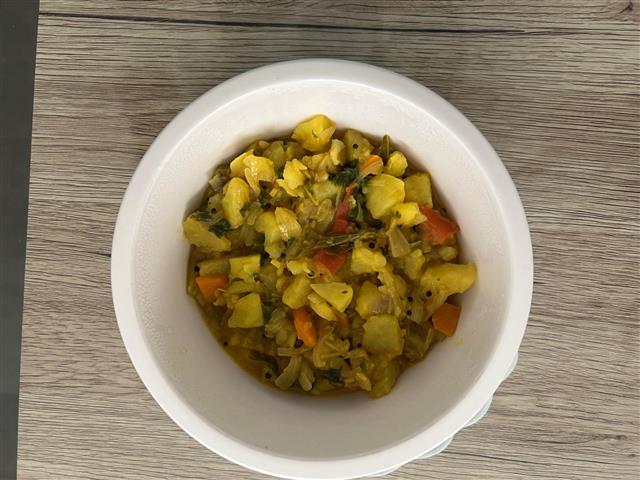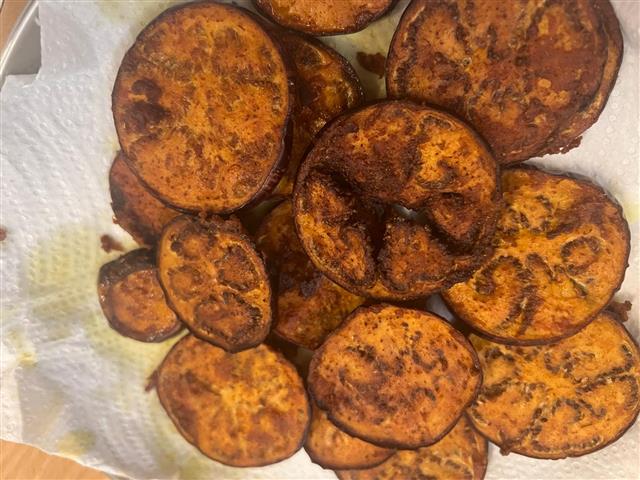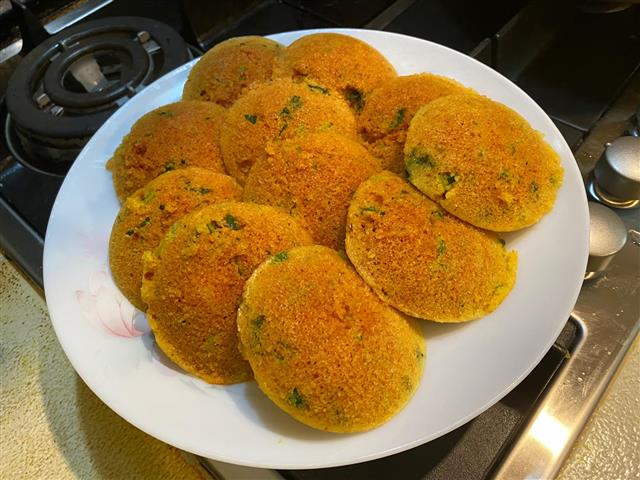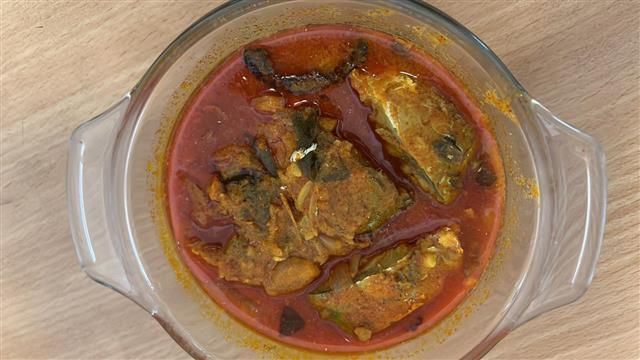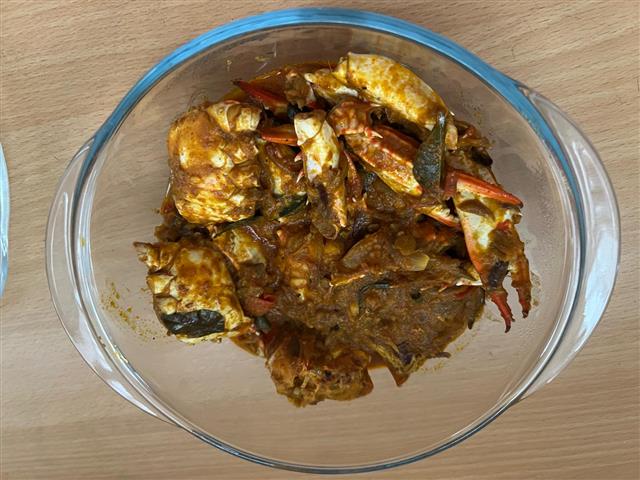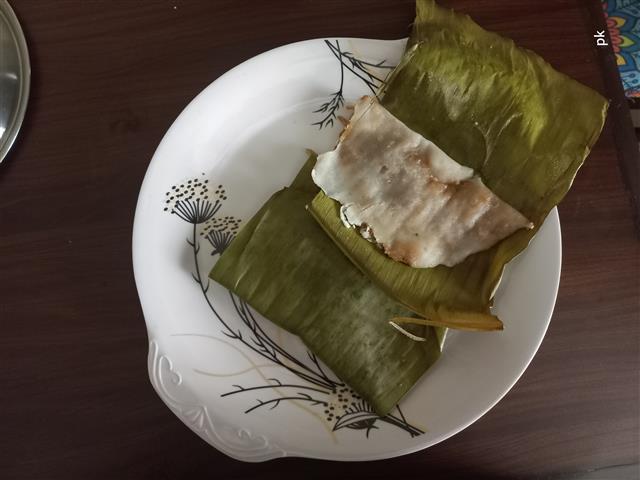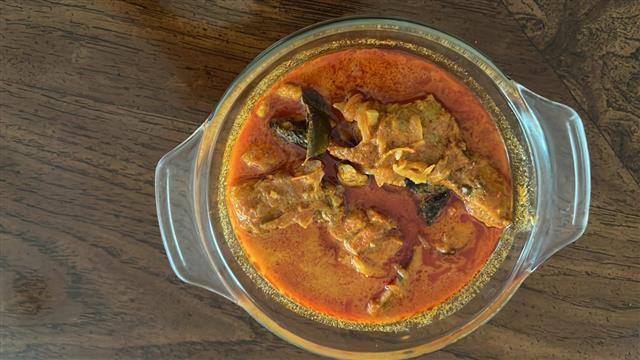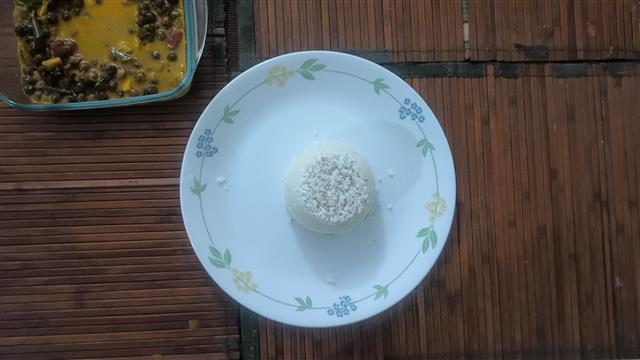
Chemmeen Curry
(4 reviews)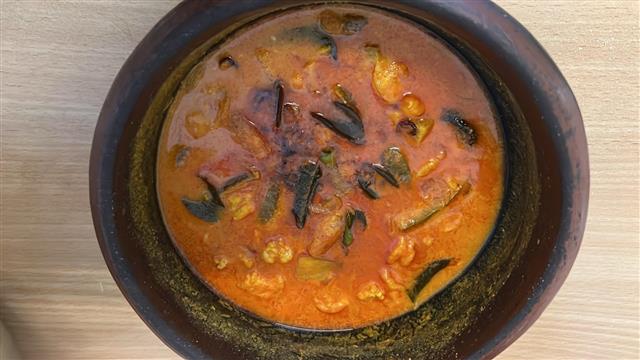
Chemmeen Curry is a creamy, tangy Kerala-style prawn curry made with a coconut milk base, green mango, and a light hint of spice. It brings together plump prawns, drumsticks, and mango in a gently spiced coconut gravy.
This version uses raw mango instead of Kudampuli (Malabar Tamarind), making it a perfect seasonal dish when mangoes are abundant. With a slightly sour and creamy broth, it's lighter than most seafood curries.
Ingredients
Directions
- Clean and unshell the prawns. Mince the ginger and chop the drumstick into 3 or 4 pieces. Chop or grate the green mango.
- In a pan, heat one tablespoon of coconut oil. Add 5 to 6 shallots, minced ginger, and curry leaves and saute.
- Add chilli powder and turmeric powder and saute. Add prawns, drumstick pieces, tamarind, and two tablespoons of cow or milk.
- Season with salt and add enough water to just cover. Cook on high flame. When the curry is boiling, add the green mango and cook it.
- When the curry is cooked, add thick coconut milk and simmer on low heat.
- In a small frying pan, heat the remaining coconut oil. Add the remaining shallots and fenugreek seeds. Fry the tempering until shallots are glossy and add to the curry.
Cooking Tips
• Simmer on medium-low heat to prevent the delicate prawns from breaking.
• Keep checking the liquid to prevent the fish from burning. Add more milk during the initial cooking, if required.
• Coconut oil is essential. Avoid using other oils, if possible.
• Use fish stock for extra flavour
• Don't overcook the prawns. Overcooked prawns become rubbery.
• Use small prawns or medium-sized ones as they soak in more flavour and cook evenly.
• Add coconut milk at the end. Simmer gently.
• Mango should be semi-ripe or firm raw. Too ripe will break down into the curry and make it too sweet.
How to Serve
• Steamed matta red rice or white rice
• Kappa (boiled tapioca) or Kanji
• Chappathi, Parotta, Puttu or Appam
• Thoran or Mezhukkupuratti(stir-fried veg) for more people
The Story Behind Chemmeen Curry
Chemmeen curry holds a special place in many Kerala kitchens, especially in coastal homes where fresh prawns are available all year round. It's often made when there's time to grate fresh coconut into thick milk and simmer the curry until the flavours settle in.
I first tried this version with mango and drumstick at a relative's home. Their grandmother added a splash of milk before the coconut milk, something I'd never seen before. It made the curry silkier without being too rich. The mango gave it a taste lift, and the prawns absorbed all the tangy-spicy coconut base.
Unlike fish or meen curry, which takes its time, this curry is quick. Prawns cook fast. It's become my go-to recipe when I need something comforting and quick.
What Is Chemmeen Curry or Prawn Curry?
Chemmeen Curry is a prawn-based curry that reflects Kerala's coastal and tropical flavours. It's made with a tempering of shallots, ginger, curry leaves, and spices, then simmered with coconut milk with mango and prawns. This is in the same style as other Kerala curries that balance heat, sourness, and creaminess.
The curry begins with a base of sautéed shallots, ginger, and coconut oil, followed by turmeric, chilli, and a mix of spice powders. Prawns are simmered briefly alongside raw mango and a touch of tamarind, giving the dish its sour-sweet note. Thick coconut milk is added towards the end to create a silky, soothing finish.
It's faster to cook than most meat curries and incredibly versatile. You can pair it with both cooked grains and flatbreads for a satisfying meal.
Why This Curry Works?
This version uses green mango instead of kudampuli, giving the curry a fruity sourness. The mango also softens in the curry by creating lovely chunks that soak up the gravy and contrast with the prawns.
The addition of drumstick (muringakka) is optional, but I recommend it as this brings a mild bitterness and absorbs the masala. The use of both regular milk and thick coconut milk provides a delicate creaminess without heaviness.
This dish also reheats well and can be easily adjusted for spice. Use tomatoes and tamarind paste when you can't find raw mangoes.
How is the Chemmeen Curry differnt from Meen Curry?
Kerala Fish curry is usually simmered slowly with kudampuli (fish tamarind) and a spiced coconut base or paste. This curry uses fenugreek, coriander powder, and more chill. Chemmeen curry cooks faster and uses green mango for tang, with a lighter, creamier coconut milk finish.
Ayala curry is made with Indian Mackerel, kudampuli, and a bolder chilli-forward base with less coconut or none at all. THis curry is more pungent, greasy, and goes better with rice. Shrimp curry, in contrast, is lighter, slightly sour and creamier, making it better suited for both grians and flatbreads
You can explore more in our Ayala Curry Recipe post and Fish Curry Recipe post, where we dive into the details of making these curries and swapping fish with other seafood including prawns.
Pro Tips for Perfect Results
→ Use unshelled prawns to save time
→ Don't cook on high heat after adding milk, as it may cause it to split.
→ Temper separately for depth. The final shallot tempering in coconut oil lifts the dish right at the end.
→ The flavour deepens if the curry is rested for a few hours.
Chemmeen Curry Variations
→ With Kudampuli
Swap mango for 1 piece of soaked kudampuli for a smoky, more traditional sourness.
→ Add Vegetables
Include ash gourd or brinjal along with drumsticks for a fuller curry.
→ Creamier Version
Add a spoonful of coconut paste for a thicker gravy.
→ Spicier Version
Increase the chilli powder or add a pinch of crushed black pepper before serving.
Diet-Friendly Adaptations
Lactose-Free: Use only coconut milk, skip dairy milk entirely.
Low-Fat Version: Use the second extract of coconut milk instead of thick milk.
No Mango: Add a pinch of tamarind paste or lemon juice at the end for tanginess and acidity.
Storing & Reheating Tips
→ Fridge: Keeps well in the refrigerator for up to 2 days. Flavors deepen overnight!
→ Reheat reheat gently over low heat. Avoid boiling after adding coconut milk.
→ Freezer: Not ideal. The coconut milk may separate and the prawns may turn rubbery.
Common Mistakes to Avoid
→ Boiling after adding coconut milk.This will cause it to split.
→ Using overripe mango. Makes the curry overly sweet and mushy.
→ Overcooking prawns. Cook just until they turn shiny and transparent.
→ Skipping tempering. The final shallot-coconut oil fry adds essential flavour and crispness.
Frequently Asked Questions
- Can I use frozen prawns or chemmeen?
Yes, just thaw completely and rinse in salted water before cooking.
- Is it okay to skip the raw mango?
Yes. Replace with a small piece of soaked kudampuli or use tomato and tamarind paste.
- Can I add coconut paste instead of milk?
Absolutely. It'll give a thicker texture and nuttier taste.
- Is this curry spicy?
It's medium-spicy. You can reduce or increase chilli powder based on preference.
- Can I use canned coconut milk?
Yes, but dilute slightly if it's very thick and add only at the end to prevent splitting.
Equipment Needed
→ Clay Pot (Mannchatti), Deep Uruli or Medium Saucepan
→ Small Kadai or Frying Pan for final tempering
→ Spatula
→ Measuring Spoons
→ Knife & Chopping Board
